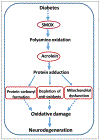Spermine oxidase: A promising therapeutic target for neurodegeneration in diabetic retinopathy
- PMID: 31207342
- PMCID: PMC7011157
- DOI: 10.1016/j.phrs.2019.104299
Spermine oxidase: A promising therapeutic target for neurodegeneration in diabetic retinopathy
Abstract
Diabetic Retinopathy (DR), is a significant public health issue and the leading cause of blindness in working-aged adults worldwide. The vision loss associated with DR affects patients' quality of life and has negative social and psychological effects. In the past, diabetic retinopathy was considered as a vascular disease; however, it is now recognized to be a neuro-vascular disease of the retina. Current therapies for DR, such as laser photocoagulation and anti-VEGF therapy, treat advanced stages of the disease, particularly the vasculopathy and have adverse side effects. Unavailability of effective treatments to prevent the incidence or progression of DR is a major clinical problem. There is a great need for therapeutic interventions capable of preventing retinal damage in DR patients. A growing body of evidence shows that neurodegeneration is an early event in DR pathogenesis. Therefore, studies of the underlying mechanisms that lead to neurodegeneration are essential for identifying new therapeutic targets in the early stages of DR. Deregulation of the polyamine metabolism is implicated in various neurodegenerative diseases, cancer, renal failure, and diabetes. Spermine Oxidase (SMOX) is a highly inducible enzyme, and its dysregulation can alter polyamine homeostasis. The oxidative products of polyamine metabolism are capable of inducing cell damage and death. The current review provides insight into the SMOX-regulated molecular mechanisms of cellular damage and dysfunction, and its potential as a therapeutic target for diabetic retinopathy. Structural and functional changes in the diabetic retina and the mechanisms leading to neuronal damage (excitotoxicity, loss of neurotrophic factors, oxidative stress, mitochondrial dysfunction etc.) are also summarized in this review. Furthermore, existing therapies and new approaches to neuroprotection are discussed.
Keywords: Diabetic retinopathy; Neurodegeneration; Neuroprotection; Oxidative stress; Polyamine metabolism; Spermine oxidase.
Copyright © 2019 Elsevier Ltd. All rights reserved.
Conflict of interest statement
Authors declare no conflict of interest.
Figures



Similar articles
-
Pharmacological Inhibition of Spermine Oxidase Suppresses Excitotoxicity Induced Neuroinflammation in Mouse Retina.Int J Mol Sci. 2022 Feb 15;23(4):2133. doi: 10.3390/ijms23042133. Int J Mol Sci. 2022. PMID: 35216248 Free PMC article.
-
SMOX Inhibition Preserved Visual Acuity, Contrast Sensitivity, and Retinal Function and Reduced Neuro-Glial Injury in Mice During Prolonged Diabetes.Cells. 2024 Dec 12;13(24):2049. doi: 10.3390/cells13242049. Cells. 2024. PMID: 39768141 Free PMC article.
-
Pharmacological Inhibition of Spermine Oxidase Reduces Neurodegeneration and Improves Retinal Function in Diabetic Mice.J Clin Med. 2020 Jan 25;9(2):340. doi: 10.3390/jcm9020340. J Clin Med. 2020. PMID: 31991839 Free PMC article.
-
Molecular Mechanisms Mediating Diabetic Retinal Neurodegeneration: Potential Research Avenues and Therapeutic Targets.J Mol Neurosci. 2018 Nov;66(3):445-461. doi: 10.1007/s12031-018-1188-x. Epub 2018 Oct 6. J Mol Neurosci. 2018. PMID: 30293228 Review.
-
Retinal Neurodegeneration as an Early Manifestation of Diabetic Eye Disease and Potential Neuroprotective Therapies.Curr Diab Rep. 2019 Feb 26;19(4):17. doi: 10.1007/s11892-019-1134-5. Curr Diab Rep. 2019. PMID: 30806815 Free PMC article. Review.
Cited by
-
Acrolein: A Potential Mediator of Oxidative Damage in Diabetic Retinopathy.Biomolecules. 2020 Nov 20;10(11):1579. doi: 10.3390/biom10111579. Biomolecules. 2020. PMID: 33233661 Free PMC article. Review.
-
Arginase Pathway in Acute Retina and Brain Injury: Therapeutic Opportunities and Unexplored Avenues.Front Pharmacol. 2020 Mar 17;11:277. doi: 10.3389/fphar.2020.00277. eCollection 2020. Front Pharmacol. 2020. PMID: 32256357 Free PMC article. Review.
-
Recent Developments in Diabetic Retinal Neurodegeneration: A Literature Review.J Diabetes Res. 2020 Dec 7;2020:5728674. doi: 10.1155/2020/5728674. eCollection 2020. J Diabetes Res. 2020. PMID: 34151902 Free PMC article. Review.
-
Pathological Role of Unsaturated Aldehyde Acrolein in Diabetic Retinopathy.Front Immunol. 2020 Oct 22;11:589531. doi: 10.3389/fimmu.2020.589531. eCollection 2020. Front Immunol. 2020. PMID: 33193419 Free PMC article. Review.
-
Arginase: Biological and Therapeutic Implications in Diabetes Mellitus and Its Complications.Oxid Med Cell Longev. 2022 Oct 26;2022:2419412. doi: 10.1155/2022/2419412. eCollection 2022. Oxid Med Cell Longev. 2022. PMID: 36338341 Free PMC article. Review.
References
-
- Cho NH, et al. IDF Diabetes Atlas: Global estimates of diabetes prevalence for 2017 and projections for 2045. Diabetes Res Clin Pract, 2018. 138: p. 271–281. - PubMed
-
- de Moraes G and Layton CJ, Therapeutic targeting of diabetic retinal neuropathy as a strategy in preventing diabetic retinopathy. Clin Exp Ophthalmol, 2016. 44(9): p. 838–852. - PubMed
-
- Imai H, et al. Neuroprotection for diabetic retinopathy. Dev Ophthalmol, 2009. 44: p. 56–68. - PubMed
-
- Jindal V, Neurodegeneration as a primary change and role of neuroprotection in diabetic retinopathy. Mol Neurobiol, 2015. 51(3): p. 878–84. - PubMed
Publication types
MeSH terms
Substances
Grants and funding
LinkOut - more resources
Full Text Sources
Other Literature Sources
Medical
Miscellaneous

